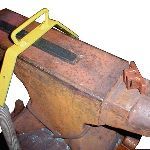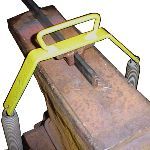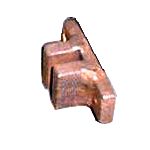| |
 |
 |
 |
 |
-GURU
|
 |
In a recent demo Hugh McDonald pointed out that a good hold down was needed to make his animal heads. There are MANY types and we are going to cover a few as well as a very nice one by Hugh McDonald.
|
 |
 |

Figure 1 |
This is a standard "hold fast" or "bent dog".
It should fit loosely in the hardy hole (about 1/6" or 2mm smaller than the hole).
If too loose it will not lock in place.
These can be made of mild steel.
|
 |
 |

Figure 2 |
Bent dogs are used a lot on weld platens (heavy iron tables with square holes). Bent dogs have the advantage of being sprung into place and when a part it welded and deflects it does not damage the dog the way it would a C-clamp.
|
 |
 |

Figure 3 |
Bent dogs are tightened by giving them a tap with a hammer.
To remove them they are struck on the back behind the corner.
When used on an anvil they should not be tightened TOO tight as it is possible to break the heal on older anvils.
|
 |
 |

Figure 4 |
Since I mentioned weld plattens these are other pieces of "furniture" used on them.
A - Flame cutting "cone" to keep the work above the table.
B - Plain dog, to clamp things against.
C - Screw clamp. Not very common.
|
 |
-GURU
|
 |
Weld plattens are often called "Acorn plates" for the popular manufacturer of them called "Acorn".
|
 |
 |

Figure 5 |
This is a nifty little clamp made by Jim "Paw-paw" Wilson. It slips into the hardy hole, wedges and then it tightened by the Vise-Grip clamp. Jim had put a slot in the shank to wedge it to the anvil but the clamp self locks like the bent dogs above.
This clamp is made from a Vise-Grip welders clamp with the bottom jaws cut off and a shank welded on.
|
 |
 |

Figure 6 |
This clamp design was sent to me by Ralph Jenkins a member of the Illinois Valley Blacksmiths Association. It is cut off a spring harrow (I think). That's a piece of farm equipmnet for you city folks.
|
 |
 |

Figure 7 |
It works like the bent dog except it is made of spring steel.
Bent dogs can usualy be made of mild steel.
|
 |
 |

Figure 8 |
A common clamp is a loop of steel flat bar with a handle welded on. This one is held down by a spring.
|
 |
 |

Figure 9 |
These are often held down by a simple dead weight. Here a chain supports a bag of scrap iron (or more old chain). Some smiths like these and keep them on their anvils because they deaden the ring.
The problem with these clamps is the free space is limited as shown in distance D in Figure 8 above.
|
 |
 |

Figure 10 |
Another popular hold down is simply a piece of roller chain (timing chain or motor cycle chain) attached to the anvil with a weight on one end.
|
 |
 |

Figure 11 |
These can also be setup using a spring and a hook. Note that the spring in this illustration is on the far side of the anvil and attached to the stand. The hook is welded to the end of the chain and attaches to a nail or bolt.
|
 |
 |

Figure 12 |
This is the hold down designed by Hugh McDonald of Western Australia (the inventor of the McDonald Roller Mill). Hugh's designs are always well thought out and this one is no differnt.
|
 |
 |

Figure 13 |
This hold down gets around the free height limitation of the typical hold down ad shown in figures 8 and 9 by using two springs.
The fancy yellow paint job was so it would show up in the photos.
|
 |
 |

Figure 14 |

Figure 15 |

Figure 16 |
 |
-GURU
|
 |
The really slick feature of this hold down it Hugh's little attachment for holding stock on edge. Its just a little loose piece made to fit the stock in use. The wide clamping surface is needed for stability.
You need to make on-edge holders for the different stock that you work with. This seems to be a drawback but this is such a uniquely handy little tool it is definitely worth it.
|
 |
-GURU
|
 |
There are also foot operated clamps that you can build into your anvil stand but these tend to get in the way unless you a a specific job you do constantly and have a dedicated anvil and stand for that job. There are drawings of them in many blacksmithing books if you are intrested.
|
 |
-GURU
|
 |
Questions? Comments?
|
 |
Dave L
|
 |
Thanks Guru
|
 |
Paw Paw
|
 |
Well done as usual, Jock. I can see small brackets on the underside of Hugh's clamp to slide different edge holders into.
|
 |
sleepingbear
|
 |
Great Demo,
|
 |
Ntech
|
 |
I like the spring loaded yellow hold down method. Know of a quick way to change for different stock?
|
 |
Fuzzysword
|
 |
do they have any of thises for sale in stores? if so were would i look for them?
|
 |
PF
|
 |
Good useful demo Guru. I like the edge holding tool
|
 |
Paw Paw
|
 |
or clips on the edge holders to slip over the flat bar of the clamp.
|
 |
Jerry
|
 |
Thanky Jock, the Hugh Mac holddown looks a lot easier to use than my cannon ball link chain.
|
 |
OErjan
|
 |
great clamps. and as you said the edge device is a case of good thinking :-) REALLY good
|
 |
OErjan
|
 |
great clamps. and as you said the edge device is a case of good thinking :-) REALLY good
|
 |
Ntech
|
 |
Thanks for the great ideas Jock. Thank Hugh for us also.
|
 |
sutton
|
 |
bent dog probably needs to be round, right.
|
 |
-GURU
|
 |
These are strictly custom made by the smith.
You would probably on need edge holders to fit 1/4", 3/8" and 1/2" stock. Making them adjustable would make them more complicated than they need to be.
I think Hugh left off clips and such that require alignemnt and might get in the way to avoid lost time.
|
 |
OErjan
|
 |
would be quite possibel to make several "lugs" for different stock sizes.
|
 |
mike-hr
|
 |
i'm thinking that two springs would rock back and forth more than one spring and a solid mount
|
 |
-GURU
|
 |
Yes, bent dogs are usualy round so they can be turned at differnt angles.
|
 |
-GURU
|
 |
The two springs must work pretty well as Hugh makes hundreds of those animal heads in his demos using this clamp setup. He says it is very fast and efficient.
|
 |
Fuzzysword
|
 |
yea it must i wonder if i can rig somting like that up...
|
 |
-GURU
|
 |
If the sides of the clamp did not drop down past the anvil two springs would be unstable. But with the arms of the clamp down low (as Hugh's clamp is made) it becomes very steady.
|
 |
Milt
|
 |
Thanks again for the info, Jock!
|
 |
sutton
|
 |
thanks for the demo. saw one at a glance and tried to copy it but had too much slack in my hardy hole. know it now.
|
 |

